DO-IT News July 2012

Volume 20, Number 2
Below are the articles of the DO-IT News July 2012 newsletter. These articles can also be seen all on one page at the Full Newsletter option.
Meet the 2012 DO-IT Scholars!
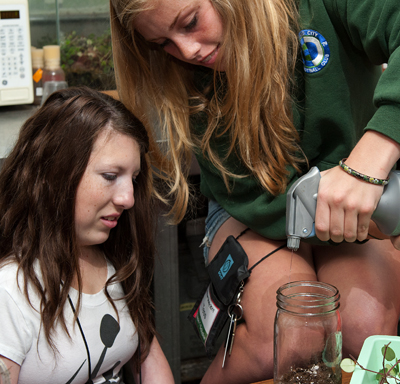
This summer DO-IT will host its 20th annual Summer Study program for DO-IT Scholars, providing participants with the opportunity to experience life on a college campus and explore challenging academic and career fields such as those in science, engineering, and computing. Primary funding for the Scholars program is provided by Washington State. Additional funding for Scholar activities is provided by Microsoft, the National Science Foundation, the National Oceanic and Atmospheric Administration, and the Boeing Company. For more information about the program, visit www.washington.edu/doit/do-it-scholars.
Please join us in welcoming the following 2012 Scholars to DO-IT! Participants are selected from sophomore and junior applicants in high schools across Washington State.
Mikayla is a sophomore at Lynnwood High School and enjoys studying math and sports medicine. Her goal is to become a pediatrician. She is involved in FIRST Robotics and was presented the "Star of the Day" award at last year's regional competition for her work as the safety lead.
Hannah is legally blind in her right eye and is from Marysville. She is a sophomore and loves learning about history and excels in math. She is a member of the Key Club and next year will be in Running Start. Basketball is a passion of hers and she would eventually like to pursue a career in physical therapy or sports medicine.
Peter is a sophomore from Woodinville. He has autism and is enthusiastic about his science and math classes. He hopes to apply math to the field of environmental science. He is a member of the Environmental Club and the Math Team at his high school. Ultimately, he wants everyone to work together to save planet Earth.
Jennifer has spastic cerebral palsy. She enjoys history, but especially likes English assignments where she can express her ideas. Not surprisingly, she excels in creative writing. Jennifer hopes to become a broadcast journalist.
Aaliyah is deaf. As a junior, she enjoys history and physical education. With her interest in both children and animals, she would someday like to work in a daycare or zoo. In the Miss Teen Washington Pageant she won "Most Spirited" award.
Lucas is a freshman and enjoys studying math and science. His goal is to eventually attend medical school to pursue studies in anesthesiology. He has a hearing impairment and Goldenhar's syndrome.
Cody, a sophomore, is enthusiastic about history and science. In the future, he would like to attend college to pursue a career in technology. He has cerebral palsy.
Lindsay enjoys writing because it helps her communicate and express her ideas. She would like to become an author or a technical writer. Her favorite classes are English and environmental science. She is currently a junior at Skyline High School in Sammamish and has Asperger's syndrome.
Eric is a high school junior from Everett. His favorite classes are journalism and French because he loves writing and learning new languages. He has a learning disability and in college would like to study forensic science in order to become a crime scene investigator.
Colton has muscular dystrophy and likes learning about history and math, especially when he finds solutions to problems. He is a junior and would like to enter a career in digital forensics or criminal justice.
Alexander, a sophomore, enjoys learning American sign language, English, and history. His passion is in the performing arts and he aims to attend college to develop his skills in theater. He has cerebral palsy.
Jessica is a sophomore from Snohomish. English, Spanish, digital arts, and history are her favorite classes. Ultimately, she wants a career that allows her to do what she loves and to help people. She has spinal muscular atrophy.
Dominique comes from North Bend. She has a form of dwarfism called Kniest syndrome. English is one of her favorite classes, and she also loves the hands-on aspect of her science class. She would like to study 2D animation and work for the Walt Disney Company.
Allison is a junior and has thrombocytopenia absent radius syndrome. She enjoys drafting, art, and woodshop, because they are hands-on, which helps her learn faster. For her career she would like to be an interior designer, architect, or an artist.
Alicia is interested in many academic areas, but has a lot of fun studying science and math. She has been very successful in her involvement with the Deaf Academic Bowl at her high school. She currently plans to attend medical school to become an ER doctor.
Grace is a sophomore and has bilateral deafness. Her favorite classes are math and science because she enjoys problem-solving and experimenting. Currently, she would like to major in science, physics, or math and pursue a career in pharmacy.
Why We Need Disability Advocacy Clubs
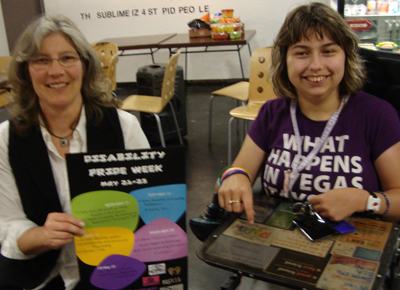
College campuses can be large and intimidating places for new students. One way students can find a community of peers is by joining a club on campus. For students with disabilities, disability advocacy clubs have become a great way to find that community. Disability advocacy groups are based around three main principles: self-advocacy/activism, disability awareness, and social events.
Groups practice self-advocacy and help each other advocate for accommodations. Groups do this by using peer mentors and having discussion groups. Students help each other get accommodations and learn other accessibility tips by sharing their experiences. Students also participate in activism by having representatives in student government and writing letters to members of the school administration.
Disability awareness and disability pride are interests of other disability clubs. Groups put on disability awareness weeks and host panels about disability issues. Clubs use the resources on campus to spread awareness about issues that involve people with disabilities to help change perceptions that people have about individuals with disabilities.
Disability Pride events take place during awareness weeks to show that people with disabilities are proud of who they are. Events can include open mic nights, art events, rallies on campus, and technology fairs.
Advocacy clubs are also social clubs! Groups mix advocacy and fun; many of the groups plan social events including game nights, bowling, and potlucks. College is a time that people like to have fun while they learn, and people with disabilities are no different.
To learn more about how to start a club on your campus visit Green Mountain Self-Advocates, www.gmsavt.org/index.php?option=com_content&view=article&id=66
To view what some clubs are doing now, visit:
Cascadia Community College's Disability Student Alliance (DSA), cascadia.collegiatelink.net/organization/AccessFutures/calendar/details/143021
University of Washington (UW) Disability Advocacy Collective, www.facebook.com/groups/220349191312292/
UW Bothell's Disability Strength Awareness and Education Alliance, orgsync.com/40609/chapter
University of Maryland, Baltimore County's Accessibili-tea, groups.google.com/group/accessibili-tea?hl=en&pli=1
University of Missouri's MU Student Exceptions, www.facebook.com/groups/124883254189276
Ambassador Profile: Jesse Shaver
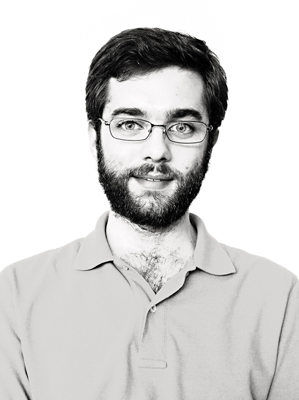
My name is Jesse, I was a DO-IT Scholar in 2003. I am a software developer for a small software consulting company in the San Francisco Bay Area. I develop custom web and mobile applications for customers in languages including Java, Groovy, C#, and JavaScript. I have worked on software projects for industries ranging from publishing to bio-medicine to finance.
I have a bachelor's degree in computer science from Goshen College in Indiana. Throughout college, I had a broad range of internship experiences from small companies and start-ups to IBM, Microsoft, and NASA. These internships gave me invaluable hands-on experience in the industry and taught me how to learn a new organization and get up to speed on a new team. I received hands-on experience in everything from software testing and development to performance tuning and benchmarking. I was given an amazing window into how each of the organizations work and an opportunity to see what I liked and disliked at each organization. In all of my internships I was a contributing member of the team with substantive projects that allowed me to improve my technical skills and contribute real value to the organization. In one internship I estimated that my hardware setup would retail for somewhere north of half a million dollars.
My disability is dyslexia, which means that having spelling checker tools are incredibly important when I write documentation and code. Despite the challenges it presents, I think my experience with dyslexia has made me good at thinking about problems and components in terms of the systems they are a part of rather than just individual pieces, which is a major benefit in my job.
I became interested in computing because I think of myself as a problem solver. I enjoy understanding problems and finding solutions to them. A lot of my job is doing exactly that—figuring out what it is that the client needs and the most effective way to meet that need. Computers happen to be my platform of choice for solving problems, which is what I am most exited and passionate about.
I think it is valuable to think about computers as a tool—a means of reaching an end. People in the technology field can impact the world by using computers and their knowledge to solve issues that they find personally important. For me these have ranged from developing cutting edge medical tools for doctors to helping people access important services easily.
DO-IT Staff Engage with Other NSF-Funded Projects
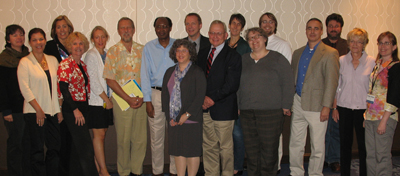
In June, Scott Bellman and I represented three projects in which DO-IT is engaged that are funded by the National Science Foundation's (NSF) Division of Human Resource Development—AccessSTEM, the RDE Collaborative Dissemination Project, and PEERs, all linked from www.uw.edu/doit. We listened to simulating presentations, engaged in lively discussions and learned about future directions of the NSF. I led a panel with a representative from each of the alliances funded by the Research in Disabilities Education program under HRD. Each project shared evidence-based activities in which they have engaged students with disabilities, including internships, think tanks focused on veterans with disabilities, online learning opportunities, mentor and peer support, academic coaching, and student learning communities. They shared their motivation for engaging students in the activity, components of the intervention, evidence of success, and lessons learned. It is expected that NSF support of activities such as these will increase the participation of individuals with disabilities in science, technology, engineering, and mathematics fields and improve these fields with the talents and perspectives of individuals with disabilities.
College of Engineering Discovery Days
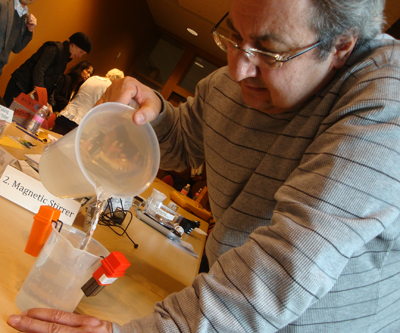
It's not often that UW departments open their doors to the public, but on April 20th and 21st, hundreds of students and teachers participated in hands-on activities at the UW College of Engineering Discovery Days in Seattle. Demonstrations by faculty and graduate students showed participants what engineers do and how they work. Exhibits were spread throughout fourteen buildings and outside on the Husky Union building lawn. Some exhibits featured computer simulations, robots, wind tunnel demonstrations, biomaterial manipulations, and nano-science experiments. The UW also offered information sessions about the university community and the admissions process.
DO-IT's AccessComputing exhibit demonstrated assistive technology such as alternate input devices to operate a computer, while an exhibit of DO-IT AccessSTEM showcased accessible science equipment such as a talking calculator and a color teller device. Several DO-IT participants stopped by for a pizza lunch, where they connected with project staff and other mentors. DO-IT participants also tried their skills at flying quad-copters with a motion-sensing device, and learned how shocking it can be to cross paths with a Van de Graaf generator! One student commented, "I am blown away by all of the awesome stuff!"
For a list of the exhibits and descriptions from the student exhibit competition, and for more information about Engineering Discovery Days, visit www.engr.washington.edu/alumcomm/discodays_exhibits.html.
Tech Tips: Keeping your Apple Computer Free From Security Threats
Until recently, many Apple computer users felt no need to worry about malware or virus attacks on their computers. As the operating system has gained in popularity so has the interest in attacking it. Just as it is important to keep up with the various updates on a Microsoft Windows computer, the same is true with Apple's OS X operating system.
Users should install all of the critical updates by clicking on the System Preferences icon in the dock (or going to the Apple Menu and selecting System Preferences), choosing Software Update and installing those that are available. The system can be set up to do this automatically or manually. It is best to leave this in the automatic mode.
Additionally, some common applications that should be updated on a regular basis are Adobe Acrobat, Adobe Flash Player, alternative web browsers to the built-in Safari [such as Firefox, Opera, or Google Chrome], and productivity software such as Microsoft Office.
The Flashback malware impacting thousands of Apple systems recently is said to be due to the delay between the time Java is updated by Oracle and the time Apple updates it internally in the operating system as they don't provide end users or Oracle direct access to that process. This has left many users of OS X running third-party workaround patches until Apple releases an official update.
Essentially the two main threats to Mac OS X are getting someone to install something they shouldn't and privilege escalation attacks.
The former is somewhat of a social engineering issue but it is very easy to just make a single account that is an admin and have little to no security on it. And most people are not very security conscious and will enter the name and password anytime an installer requests it. Setting up a secondary account without admin access does help with this but you still actually need to think about security and if you really need to install things, especially from an untrusted source.
The later is where someone gains access to the machine via a non-admin account (might be a system account running a service you've enabled or it could be secondary account with a not very secure password). Once you've gained access to the machine there are a number of unix based exploits that can be tried to escalate the privileges of the account until you have admin and/or root access.
There is no replacement for being security minded. Choosing good passwords, running in a non-admin capacity, and being cautious about when you enter your admin account information goes a very long way to keeping your computer safe.
The Thread: Crossing Safely
I wanted to share with you a question posed by a DO-IT Ambassador in our Internet discussion forum and some of the responses so that you can get the flavor of the many rich conversations the DO-IT community has online. Some forum posts are edited for clarity and brevity.
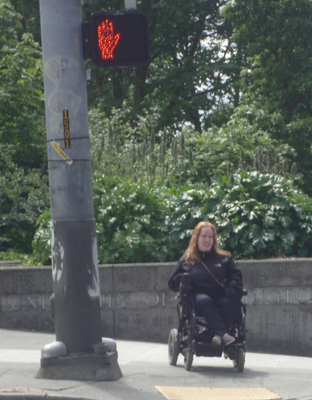
I need advice. I was crossing the street with a walk signal in my wheelchair, I checked before I went into the street and a car came around the corner and almost hit me. It was only a few inches away. This is about the third or fourth time I have almost been hit by a car. I didn't hear it, and I didn't see it within my field of vision. I'm terrified that I am going to be hit by a car one of these days. I have taken orientation and mobility training, and I know that I am doing everything as I should. I want to have independence to travel throughout the city, just like everyone else my age. Has anyone else been in a situation like this, and what did you do?
DO-IT Ambassador: I do not use a wheelchair, but have encountered some risky situations when crossing roads. First of all, as a person with a visual impairment, I have to listen for parallel traffic in order to know when it is my turn to cross. There have been several occasions when I would be standing at an intersection in downtown Portland, hearing traffic running parallel to me, and thinking it is my turn to cross the road. However, before I even get half way across, an oncoming vehicle turns right in front of me. I end up having to back up out of the road and wait for the next traffic cycle in order to keep from getting run over. I remember one time I was coming home from the state commission for the blind. In order to get to the bus stop, I needed to cross a very accessible road. I simply have to listen for traffic on Stark Street. Just as I was about to cross, a motorcycle turned right in front of me. I had to back up out of the road and wait for another signal in order to keep him from running over me.
DO-IT Ambassador: I do not know about all the parking garages, but at the one I frequently walk by, there is no auditory signal to tell me that there is a vehicle approaching. There are a few intersections that have audible traffic signals, but those are few and far between.
Original Poster: Even if an audible traffic signal is available it doesn't always mean that drivers are watching to see who is in the crosswalk. I didn't hear the car, perhaps it was a hybrid. Nonetheless it snuck up on me before I could see it with the remaining vision I do have. I can't see peripherally or downward. Lucky for me I didn't have my hood on my head or I definitely would have been hit.
DO-IT Ambassador: I can 100% relate! I use a power chair to get around, and I take the city bus everywhere. I have to cross the street coming home each day and I came close myself to getting hit about three months ago. I was brushed by a car but thankfully it was an elbow burn and the driver did stop and admit she took her eye off the road for just a split second. It scared the life out of me! She gave me her phone number for future reference and we went our separate ways.
DO-IT Scholar: All I can really suggest is to be cautious whenever you go out onto a road (which I'm sure you already do) even in a quiet road. Actually, a quiet road might be where the most caution is needed. I know I tend to relax my attention when crossing a quiet street because I don't expect a car to come close enough to be a danger. Do you have a flag or anything on your wheelchair? I've seen people with orange flags on their scooter. It might be a good idea to have one if you don't. There are drivers out there who drive dangerously; so there is nothing you can do but to be vigilante and make yourself as visible as possible. And it sounds like you're already doing this.
DO-IT Ambassador: Although I'm not in a wheelchair, I have the exact same problem because I am blind on the left side, so I can't see cars turning. It's really terrifying because I have been hit by a car, and in the crosswalk! I always make sure to walk the extra block or two to a crosswalk with a signal so cars are more aware, but sometimes the crosswalk pole or light pole can effect whether or not a car can see you, so make sure you are completely visibly to traffic, even if you think there are no cars coming, because I have almost been hit many time by cars turning right on a red light. I also make sure to walk with my cane everywhere if I'm alone.
DO-IT Ambassador: Try to make eye contact with the drivers that are either stopped or coming up to the turn lane. If you can't make eye contact, don't begin to cross. I also try to make sure someone else is in the crosswalk with me, even if I don't know them. If I'm walking to campus, I'm pretty much guaranteed that other people will be out walking as well. Sometimes I'll go a little out of my way just to make sure I can "follow" someone else. Standing on the corner, waiting for the light to change is a good way to make friends too.
How Can You DO-IT?
- Sign up to receive DO-IT News if this newsletter was not mailed directly to you.
- Volunteer as a Mentor or to help with one of our Summer Study programs.
- Pass this newsletter on to someone you know who can benefit from our programs.
- Donate money to support and extend DO-IT activities including sponsoring Scholars from states outside of Washington, special events, work-based learning experiences, participant attendant or travel costs, refreshments for program participants, and creation and distribution of educational videotapes and publications.
DO-IT today by completing the form below! You may also make a secure online credit card donation at the University of Washington Make a Gift page by selecting the "DO-IT Program Gift Fund" option.
___ Sign me up to receive copies of DO-IT NEWS, a free program newsletter.
___ Send me more information about DO-IT volunteer opportunities.
___ I would like to make a donation (payable to the University of Washington, Federal ID#91-6001537) to support DO-IT operations.
___ I have enclosed a check for $____________
___ Please charge $____________ to my credit card.
___ VISA ___ Mastercard
Date _____________
Card Number __________________________ Expiration Date _____________
Card Holder Name ___________________________________________________
Signature _____________________________________________________
Address ____________________________________________________________
City __________________________ State _____________ Zip ____________
Phone: Home __________________________ Business ____________________
E-mail: ____________________________________________________________
Your gift is tax-deductible as specified in IRS regulations. Pursuant to RCW 19.09, the University of Washington is registered as a charitable organization with the Secretary of State, State of Washington. For more information, call the Office of the Secretary of State, 1-800-322-4483.
Mail to:
DO-IT
University of Washington
Box 354842
Seattle, WA 98195-4842
Thank you!
More About DO-IT
DO-IT News is published at the University of Washington with input from DO-IT staff, Pals, Scholars, Ambassadors, and Mentors. DO-IT is primarily funded by the National Science Foundation, the U.S. Department of Education, and the State of Washington.
DO-IT (Disabilities, Opportunities, Internetworking, and Technology) serves to increase the successful participation of individuals with disabilities in challenging academic programs such as those in science, engineering, mathematics, and technology. Primary funding for DO-IT is provided by the National Science Foundation, the State of Washington, and the U.S. Department of Education. DO-IT is a collaboration of UW Information Technology and the Colleges of Engineering and Education at the University of Washington.
Grants and gifts fund DO-IT publications, videos, and programs to support the academic and career success of people with disabilities. Contribute today by sending a check to DO-IT, Box 354842, University of Washington, Seattle, WA 98195-4842.
Your gift is tax deductible as specified in IRS regulations. Pursuant to RCW 19.09, the University of Washington is registered as a charitable organization with the Secretary of State, state of Washington. For more information call the Office of the Secretary of State, 1-800-322-4483.
To order free publications or newsletters use the DO-IT Publications Order Form; to order videos and training materials use the Videos, Books and Comprehensive Training Materials Order Form.
For further information, to be placed on the DO-IT mailing list, request materials in an alternate format, or to make comments or suggestions about DO-IT publications or web pages contact:
DO-IT
University of Washington
Box 354842
Seattle, WA 98195-4842
doit@uw.edu
www.uw.edu/doit
206-685-DOIT (3648) (voice/TTY)
888-972-DOIT (3648) (voice/TTY)
206-221-4171 (fax)
509-328-9331 (voice/TTY) Spokane
Founder and Director: Sheryl Burgstahler, Ph.D.